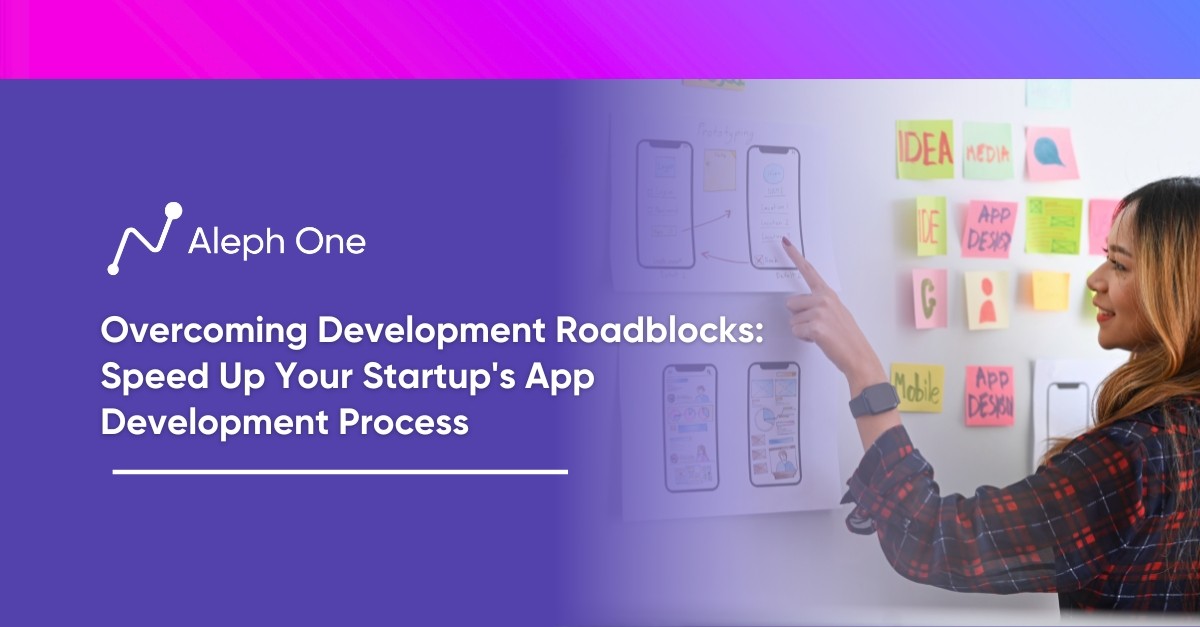Let’s work together to build something amazing. Share your project details and our team will reply to figure out the next steps to your success.

The need for app development is crucial to a startup’s success. This article will explore the strategies startups can employ to overcome the development roadblocks that threaten to slow them down. From the limitations of traditional methodologies to the game-changing potential of agile approaches and rapid application development, we elaborate on how startups can harness these concepts to their advantage.

The Startup’s Race Against Time: Why You Need to Fast-Track App Development
For startups, speed is everything. In a race to gain traction, startups must move fast to build their apps and products before competitors beat them to market or funding runs out. Slow and steady development won’t cut it.
Limited Time to Attract Investors, Customers & Talent
Startups often only have a small window of opportunity to gain momentum. They have limited time to attract investors, customers, and new hires before their funding is depleted. If startups can’t gain traction and show progress quickly, their funding and future may dry up.
Capitalize on New Technologies and Customer Needs
In the fast-paced tech world, ideas and trends are fleeting. The cutting-edge app that wows investors today may seem outdated in a few months. Startups have to rush to capitalize on new technologies and customer needs before the moment passes. Apps and products need to be developed at faster speeds.
Gain a Competitive Advantage
Competitors won’t wait around. Multiple startups are working on similar ideas and products in nearly every industry. The startup that can develop and launch their app first has the best chance of success. Laggards risk losing customers and credibility. Speed is critical to gaining a competitive advantage.
Pivot with Customer Feedback
With so much on the line, startups can’t afford long, drawn-out development cycles. They need methodologies and strategies tailored for speed. Waterfall development with rigid schedules and requirements won’t work. Startups must adopt an agile approach that allows for rapid changes. They need to find ways to build minimum viable products quickly and refine them on the fly based on customer feedback.
For startups, fast app development is non-negotiable. It’s the only way to survive and thrive. By accelerating their process, focusing maniacally on speed, and avoiding roadblocks, startups can turn their vision into a reality before their opportunity slips away. The need for speed is real. Startups that want to win the race must develop their apps rapidly and relentlessly. Slow and steady won’t win this race.
How Rapid App Development Fuels Startup Success
For startups, slow and steady does not win the race. Traditional app development methodologies like the waterfall model are ill-suited for the startup world, where speed and agility are essential. The waterfall model is a linear process with distinct requirements, design, development, testing, and deployment phases. While this structured approach works for long-term, complex projects with stable requirements, it fails for startups.
Customer Needs Evolve, Startups Need Speed and Flexibility
Startups operate in a state of constant change and uncertainty. Customer needs evolve, new competitors emerge, and pivots are often required. By the time you reach the end of the waterfall cycle, the requirements and market may have shifted significantly. Startups need a development methodology built for speed and flexibility.
What is Rapid Application Development (RAD)?
Rapid application development (RAD) is an agile methodology tailor-made for startups. RAD prioritizes fast prototyping and iterative development. Instead of rigid phases, RAD is a flexible and cyclical process. You start with a quick prototype, gather user feedback, refine and improve, and continue rapid iterations. This allows you to release a “minimum viable product” quickly, test key assumptions, and make changes on the fly based on user input.
What Does RAD Focus On?
RAD’s accelerated timeframe compresses the development cycle into weeks or months rather than years. To achieve this speed, RAD focuses on:
- Prototyping: Creating quick prototypes to test concepts and get user feedback. Prototypes are disposable and imperfect but provide value.
- Iterative design: Redesigning and improving the app in rapid cycles based on user feedback. No upfront “big design upfront.”
- Agile development: Using short sprints, cross-functional teams, and daily standups to build apps in an iterative fashion. New features are released in increments.
- Continuous testing: Testing throughout the process, not just at the end. Both automated testing and user testing are employed to catch issues early.
- Flexible requirements: Accept that requirements will change, and the app may pivot based on testing and feedback. The focus is on speed and learning, not rigid plans.
RAD’s speed, flexibility, and iterative nature are transformative for startups. By releasing early and improving often, RAD allows startups to build momentum, gain valuable insights, and beat competitors to market. In the startup world, RAD is the only methodology that can keep up with the pace.
App Development on Steroids: How to Build Apps at Breakneck Speeds
To accelerate your app development, you must leverage tools and techniques to streamline the process. Rapid app development platforms are ideal for startups looking to build and launch their apps quickly. These platforms provide pre-built components, modules, and templates that you can drag and drop to construct your app. This allows you to build apps without coding from scratch.
Low-code and No-code Platforms
Low-code and no-code platforms like Appian, Mendix, and Appy Pay allow you to create web and mobile apps through a simple visual interface. You can build apps for iOS and Android, connect to data sources, add business logic and workflows, and design user interfaces by pointing and clicking. These platforms generate the underlying code for you, speeding up development.
React Native or Flutter – Customized Solutions
For a more customized solution, use a framework like React Native or Flutter to build cross-platform mobile apps. These frameworks allow you to reuse much of the same code for iOS and Android apps. You still need to code, but you can save significant time by not building separate native apps.
Interactive User Interfaces & Frontend Apps
If building web apps, consider a JavaScript framework like Vue.js or React. These make it fast and easy to construct interactive user interfaces and front-end applications. They provide reusable components and optimize the rendering of elements.
Pre-built Components
To further accelerate development, use a design system with pre-built components that ensure consistency across your web and mobile apps. Systems like Material Design by Google and Bootstrap provide kits of UI elements, patterns, and guidelines for a polished look and feel.
App Templates
Leverage app templates whenever possible. Whether you need an ecommerce app, event app, messaging app, or other common use case, templates can give you a head start. Look for open-source templates or purchase affordable commercial licenses.
With the right tools and techniques, startups can build full-featured web and mobile apps in a fraction of the time. By reusing elements, automating processes, and avoiding excessive custom coding, your small team can release apps fast. The faster you can build and launch, the quicker you can get feedback, iterate and accelerate your startup’s success.
Assemble Your Pit Crew: How to Build a High-Performance Development Team
Moving fast often means assembling a small but highly skilled development team for startups. Like a racing pit crew, your developers should be able to work quickly and efficiently together to get new code and features out the door at breakneck speeds. Here are some tips for building your all-star app development team:
Focus on Quality Over Quantity
Don’t get caught up in hiring a large team. For startups, it’s best to hire only the most talented and experienced developers you can find. A small group of highly skilled developers will outperform a large team of mediocre ones any day.
Hire Specialists for Key Roles
Ensure you have specialists on your team for important roles like lead developer, UX designer, and QA tester. These specialists will ensure you have expertise in critical areas and the overall quality of your work remains high even when moving fast.
Choose Developers with Relevant Experience
Look for developers who have experience building the type of app you need. For example, hire developers with a proven track record of success building iOS apps if you’re developing an iPhone app. Relevant experience means they’ll be up and running from day one.
Provide the Latest Tools and Technologies
Give your developers the tools and tech they need to work efficiently. This includes devices like powerful laptops and software like version control systems, project management platforms, and collaboration tools.
Promote a Culture of Speed and Agility
Encourage your team to move fast by setting aggressive deadlines and milestones. Make it clear that quickly developing a minimum viable product is more important than perfection. A culture focused on speed, agility, and “good enough” quality will help your developers move at the pace your startup demands.
With a small team of highly skilled and experienced developers, the latest tools and technologies, and a culture that values speed and agility over perfection, your development team will be equipped to build apps at the rapid rate your startup needs to succeed. Focus on assembling your “pit crew,” and they’ll keep your startup in the fast lane.
Move Fast and Break Things: Agile Strategies to Accelerate Your App Development
For startups, speed is everything. Following traditional software development methodologies like the waterfall model won’t cut it. Instead, startups need to adopt an agile approach emphasizing rapid iteration, constant feedback, and the flexibility to change directions quickly.
Agile Methodology
The agile methodology known as Scrum is ideal for startups. It involves breaking down the development process into short “sprints,” typically lasting 1-4 weeks. At the start of each sprint, the team commits to a set of features or work items to complete. They then meet daily for quick “scrums” to report progress, flag any blockers, and make adjustments to stay on track. New features are demoed at the end of the sprint, and feedback is incorporated into the next sprint.
Iterative Approach
This iterative approach allows startups to quickly release a minimum viable product (MVP), gather user feedback, and make frequent improvements and course corrections. Startups can also pivot in a new direction based on feedback without abandoning months of work. The short sprints help keep teams motivated and accountable while maintaining momentum.
How to Implement Scrum
To implement Scrum, startups need to commit to the methodology fully. Assign a Product Owner to prioritize features, and have cross-functional teams meet daily for 15-minute scrums. Use a physical or digital scrum board to visualize work in progress and align the entire team. Most importantly, be willing to change directions quickly based on feedback. Scrum only works if you embrace agility and “move fast and break things.”
While Scrum is a popular agile framework, but startups can also experiment with their methodologies. The keys are keeping iterations short, continuously demoing and testing with users, and being willing to change directions rapidly. Startups that master agility and accelerate their pace of development will be poised to disrupt their industries before more established competitors even start moving.
Avoiding Roadblocks and Maximizing Momentum
Common Roadblocks
As a startup, you must minimize anything slowing down your app development process. Be on the lookout for common roadblocks like:
- Scope creep: It’s easy for startups to add new features and change the app’s scope continually. But this “feature creep” can quickly derail schedules and budgets. Define the minimum viable product, and stick to that scope. Get user feedback before adding more features.
- Communication breakdowns: With many startups working quickly, communication issues are bound to arise. Have daily stand-up meetings, use collaboration tools like Slack, and make sure everyone is on the same page about priorities and responsibilities.
- Technical debt: Taking shortcuts to speed up development often means technical debt that has to be paid off later. While moving fast is good, ensure your code is clean, scalable, and well-documented. Refactor and optimize when needed.
- Resource constraints: Not having enough developers or other resources is a common roadblock. Be realistic about how much work your team can handle, and hire contractors or consultants if needed to prevent burnout.
- Lack of expertise: If your team lacks experience in a certain technical area or with new tools, it can slow you down. Invest in training and education for your developers, and consider hiring experts to help get your team up to speed.
How to Keep Momentum Going
To keep the momentum going, focus on the following:
- Continuous integration and deployment: Deploy updates frequently through continuous integration tools to get fast feedback and reduce risk.
- Automation: Automate as much of the routine tasks as possible, like testing, documentation, and deployment. This frees up your developers to focus on building the actual app features.
- Metrics monitoring: Closely monitor key metrics like feature usage, adoption, and customer feedback. See what’s working and make quick iterations to optimize the user experience. Pivot fast if needed.
- Morale and motivation: Celebrate wins, bring in snacks, and encourage breaks to recharge. A motivated, energized team will move faster than a burnt-out one. Help your developers stay passionate about building the best possible app.
Avoid Roadblocks and Speedtrack Your Startups Success
With diligence and the right strategies, you can avoid major roadblocks, recover quickly from issues, and keep your startup’s app development in the fast lane. Speed and agility are everything, so make momentum your top priority.
FAQ
Could you provide more insights into how a startup can effectively implement the Rapid Application Development (RAD) methodology?
Implementing Rapid Application Development (RAD) could be an effective strategic approach for startups aiming to fast-track app development. To put this into practice, startups must prioritize delivering a Minimum Viable Product (MVP) as quickly as possible. This MVP serves as a basic version of the app. Upon release, immediate user feedback can be used for subsequent refinements. Remember, the essence of RAD is continual improvement via swift iterations rather than delaying the release to achieve a perfect product.
What are some of the best practices for assembling a highly competitive and efficient development team?
When assembling a high-performance development team, focus on hiring based on quality over quantity. Your startup might be better served by a small team of highly experienced and talented developers than a larger team of average talent. Having specialists in key roles, such as a lead developer, UX designer, and QA tester, is also critical. These individuals ensure that expertise is distributed across all critical areas, keeping the work quality high even as you press for speed. Make sure to equip your team with modern tools and technologies necessary for optimal performance and foster a culture of speed and agility without compromising on quality.
How can startups balance the need for speed in development and the risk of accumulating technical debt?
Balancing the need for rapid development and avoiding technical debt is definitely a challenge for startups. While faster development often demands shortcuts in coding, this could eventually lead to the accumulated debt of solving these expedited codes in the future. To strike a balance, startups should set clear and practical guidelines that define their coding standards. Regular code reviews can help ensure that these standards are adhered to. Furthermore, allocating specific time for refactoring code during the development process can help maintain code quality. Incorporating automation in processes like testing can also minimize errors resulting from rushed development, thus reducing potential technical debt.
Get the latest news and updates from Aleph One in your inbox.



